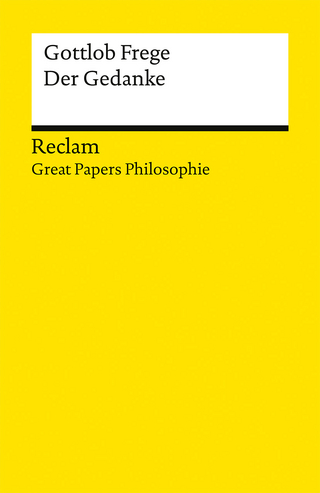
Good Reasoning Matters!:
Oxford University Press, Canada (Verlag)
978-0-19-544575-6 (ISBN)
With new features including a glossary, chapter summaries, and extensive revised exercises throughout, Good Reasoning Matters! is an essential text for courses in critical reasoning.
The fifth edition of Good Reasoning Matters! offers:
A straightforward and valuable introduction to the principles of good reasoning.
Many new examples of arguments drawn from a variety of classical and contemporary sources.
Significant discussion of non-verbal -- especially visual-arguments.
Updated features including a glossary, chapter summaries, and links to exercises and quizzes online.
A revamped companion website with additional resources for both instructors and students.
Professor Leo A. Groarke is professor of philosophy and provost at the University of Windsor. His research interests include the history of ideas, social and political philosophy, informal logic, and argumentation theory. He has published numerous books, chapters, and journal articles in these and other areas. Professor Christopher W. Tindale is professor of philosophy at the University of Windsor. His research interests include argumentation theory, ethics, and ancient philosophy. He has published numerous book chapters and extensively in journals and is the author of Fallacies and Argument Appraisal (2007) and Rhetorical Argumentation (2004). He is co-editor of the journal Informal Logic.
PREFACE; ACKNOWLEDGEMENTS; 1. WHY MAKE ROOM FOR AN ARGUMENT?; EXERCISE 1A; 2. DEFINING ARGUMENT; EXERCISE 1B; 3. ARGUERS AND SYSTEMS OF BELIEF; EXERCISE 1C; 4. AUDIENCES; EXERCISE 1D; 5. OPPONENTS AND PROPONENTS; EXERCISE 1E; 6. SUMMARY; MAJOR EXERCISE 1M; 1. BIAS; EXERCISE 2A; 2. DETECTING ILLEGITIMATE BIASES; EXERCISE 2B; 3. DIFFICULT CASES; EXERCISE 2C; 4. SUMMARY; MAJOR EXERCISE 2M; 1. BURDEN OF PROOF; EXERCISE 3A; 2. STRONG ARGUMENTS; EXERCISE 3B; 3. LOGICAL CONSEQUENCE: DEDUCTIVE AND INDUCTIVE VALIDITY; EXERCISE 3C; 4. CONTEXTUAL RELEVANCE; EXERCISE 3D; 5. SCHEMES AND COUNTER-SCHEMES; EXERCISE 3E; 6. SUMMARY; MAJOR EXERCISE 3M; 1. SIMPLE AND EXTENDED ARGUMENTS; EXERCISE 4A; 2. INFERENCE INDICATORS: DISTINGUISHING ARGUMENTS AND NON-ARGUMENTS; EXERCISE 4B; 3. ARGUMENTS WITHOUT INDICATOR WORDS; EXERCISE 4C; 4. ARGUMENTS AND EXPLANATIONS; EXERCISE 4D; 5. ARGUMENT NARRATIVES; EXERCISE 4E; 6. SUMMARY MAJOR EXERCISE 4M; 1.ARGUMENT DIAGRAMS: SIMPLE ARGUMENTS; EXERCISE 5A; 2. DIAGRAMMING EXTENDED ARGUMENTS; EXERCISE 5B; 3. LINKED AND CONVERGENT PREMISES; EXERCISE 5C; 4. SUPPLEMENTED DIAGRAMS; EXERCISE 5D; 5. DIAGRAMMING YOUR OWN ARGUMENTS; EXERCISE 5E; 6. SUMMARY; MAJOR EXERCISE 5M; 1. SPEECH ACTS AND THE PRINCIPLES OF COMMUNICATION; EXERCISE 6A; 2. HIDDEN CONCLUSIONS; EXERCISE 6B; 3. HIDDEN PREMISES; EXERCISE 6C; 4. NON-VERBAL ELEMENTS IN ARGUMENT: FLAGS AND DEMONSTRATIONS; EXERCISE 6D; 5. SYMBOLS AND METAPHORS; EXERCISE 6E; 6. A NOTE ON ARGUMENT CONSTRUCTION; EXERCISE 6F; 7. SUMMARY; MAJOR EXERCISE 6M; 1. USING WORDS PRECISELY; EXERCISE 7A; 2. VAGUENESS AND AMBIGUITY; EXERCISE 7B; 3. FORMULATING DEFINITIONS; EXERCISE 7C; 4. RULES FOR GOOD DEFINITIONS; EXERCISE 7D; 5. EXPRESSING YOUR INTENDED MEANING; 6. SUMMARY; MAJOR EXERCISE 7M; 1. ACCEPTABLE, UNACCEPTABLE, OR QUESTIONABLE?; EXERCISE 8A; 2. CONDITIONS OF ACCEPTABILITY; EXERCISE 8B; 3. CONDITIONS OF UNACCEPTABILITY; EXERCISE 8C; 4. INTERNAL RELEVANCE; EXERCISE 8D; 5. SUFFICIENCY; EXERCISE 8E; 6. APPLYING THE CRITERIA; 7. SUMMARY; MAJOR EXERCISE 8M; 1. GENERALIZATIONS; EXERCISE 9A; 2. POLLING; EXERCISE 9B; 3. GENERAL CAUSAL REASONING; EXERCISE 9C; 4. SUMMARY; MAJOR EXERCISE 9M; 1. PARTICULAR CAUSAL REASONING; EXERCISE 10A; 2. ARGUMENTS FROM IGNORANCE; EXERCISE 10B; 3. SCIENTIFIC REASONING; 4. THE SCIENTIFIC METHOD; EXERCISE 10C; 5. SUMMARY; MAJOR EXERCISE 10M; SCHEMES OF VALUE; 1. SLIPPERY-SLOPE ARGUMENTS; EXERCISE 11A; 2. ARGUMENTS FROM ANALOGY; EXERCISE 11B; 3. APPEALS TO PRECEDENT; EXERCISE 11C; 4. TWO-WRONGS REASONING; EXERCISE 11D; 5. SUMMARY; MAJOR EXERCISE 11M; ETHOTIC SCHEMES; 1. PRO HOMINE; EXERCISE 12A; 2. AD POPULUM ARGUMENTS; EXERCISE 12B; 3. ARGUMENTS FROM AUTHORITY; EXERCISE 12C; 4. AD HOMINEM; EXERCISE 12D; 5. ARGUMENTS AGAINST AUTHORITY; EXERCISE 12E; 6. APPEAL TO EYEWITNESS TESTIMONY; EXERCISE 12F; 7. GUILT (AND HONOUR) BY ASSOCIATION; EXERCISE 12G; 8. OTHER CASES; EXERCISE 12H; 9. SUMMARY; MAJOR EXERCISE 12M; ESSAYING ARGUMENT; 1. THE GOOD EVALUATIVE CRITIQUE; EXERCISE 13A; 2. THE GOOD ARGUMENTATIVE ESSAY; EXERCISE 13B; 3. A STUDENTS PAPER; 4. CONCLUSION; 5. SUMMARY; MAJOR EXERCISE 13M; 1. CATEGORICAL STATEMENTS; EXERCISE A1; 2. IMMEDIATE INFERENCES; EXERCISE A2; 3. CATEGORICAL SYLLOGISMS; EXERCISE A3; 4. VENN DIAGRAMS; MAJOR EXERCISE A(M); 1. SIMPLE AND COMPLEX PROPOSITIONS; EXERCISE APPENDIX B1; 2. DISJUNCTIONS AND CONDITIONALS; EXERCISE APPENDIX B2; 3. TRANSLATION; EXERCISE APPENDIX B3; 4. PROPOSITIONAL SCHEMES AND PROOFS; EXERCISE APPENDIX B4; MAJOR EXERCISE B(M); 1. CONDITIONAL PROOFS; EXERCISE APPENDIX C1; 2. REDUCTIO AD ABSURDUM; EXERCISE APPENDIX C2; 3. DILEMMAS; EXERCISE APPENDIX C3; 4. DE MORGANS LAWS; EXERCISE APPENDIX C4; 5. SUMMARY: RULES OF INFERENCE; MAJOR EXERCISE C(M); GLOSSARY OF KEY TERMS; CREDITS; INDEX
| Zusatzinfo | 38 photos; 83 figures; 2 tables |
|---|---|
| Sprache | englisch |
| Maße | 178 x 228 mm |
| Gewicht | 674 g |
| Themenwelt | Geisteswissenschaften ► Philosophie ► Logik |
| ISBN-10 | 0-19-544575-9 / 0195445759 |
| ISBN-13 | 978-0-19-544575-6 / 9780195445756 |
| Zustand | Neuware |
| Haben Sie eine Frage zum Produkt? |
aus dem Bereich


